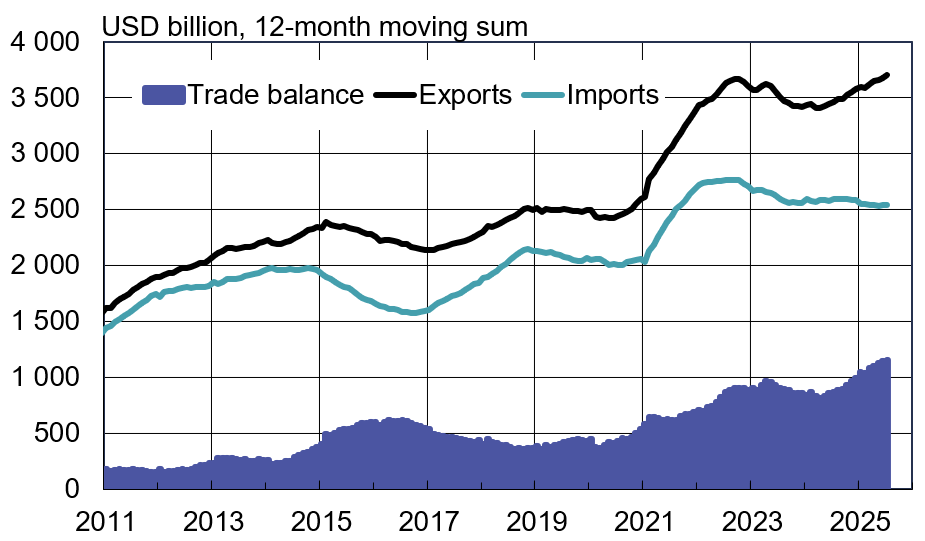BOFIT Weekly Review 34/2025
Despite ongoing strong export growth, China’s economy slowed overall in July
China’s core economic indicators for July reflected the impacts of American tariffs and weak domestic consumer demand. China’s National Bureau of Statistics (NBS) reports that July’s industrial output growth figure (5.7 % y-o-y) was the weakest reading of 2025. The official manufacturing purchasing managers’ index (PMI) also fell to 49.3, undershooting the above-50 positive readings. Early this year, the threat of higher US tariffs drove a sharp increase in Chinese industrial output as firms braced for tariffs by filling their inventories before the threatened tariffs kicked in. As the tariff situation has become partly clearer, the impact of the new arrangements has begun to appear in the Chinese economy. On the other hand, the value of China’s monthly goods exports rose to $322 billion in July, an increase of 7.1 % y-o-y. While the July figure exceeded June (5.6 %) and May (4.5 %), it came nowhere close to the figures for March (12.2 %) when the rally for pre-tariff goods was the highest. Exports to the US continued to decline, falling by 21.6 % y-o-y in July. Robust export growth to the EU (up 9.3 %) and ASEAN countries (up 16.8 %) helped offset the collapse of US trade, allowing the overall growth performance to remain quite strong. The change in Chinese goods imports for July was 3.5 % y-o-y, an increase from 0.8 % reported in June. Import growth was led by trade in microchips and raw materials. Growth in fixed investment weakened (nominal growth of 1.6 % in January-July) from the June year-to-date reading (2.8 %). Ongoing weakness in the construction sector continued to depress fixed investment, but investment was also down for infrastructure and industrial investment. Employment figures remained in the doldrums and urban unemployment rose to 5.2 %.
China’s core economic indicators weakened in July

Sources: NBS, Macrobond and BOFIT.
The performance of retail sales in July was also the weakest monthly reading this year (up 3.6 % y-o-y in real terms). Domestic consumer demand has become a major focus for China as a driver of economic growth. The offering of a range of subsidies to encourage households to replace their old home appliances sent many consumers shopping for durable goods during the first half of this year. Retail sales figures for May and June were still relatively strong (up 4.7 % and 6.5 %, respectively.) It now appears that the measures to stimulate consumption have reached a point of diminishing returns. The support programme placed significant burdens on local government finances and required the central government to allocate additional budget funds to finance the programme in July. In response to years of deflationary pressure from weak domestic consumer demand, China’s leadership has decided to tackle the problem of excessive domestic corporate price competition, now known as “involution” (nèijuǎn, 内卷). At a politburo meeting in late July, China announced the extension of economic support measures, but has since failed to announce further concrete measures.
The value of both Chinese imports and exports rose in July
Sources: China Customs and BOFIT.